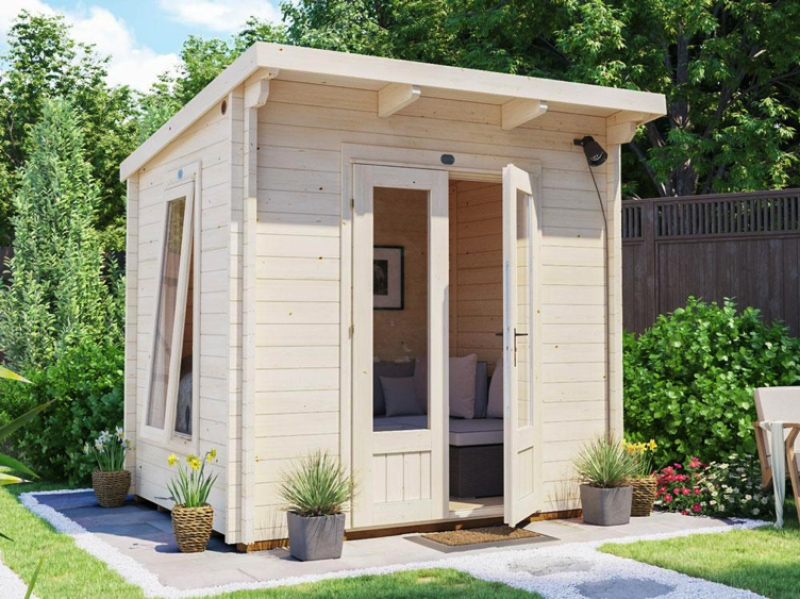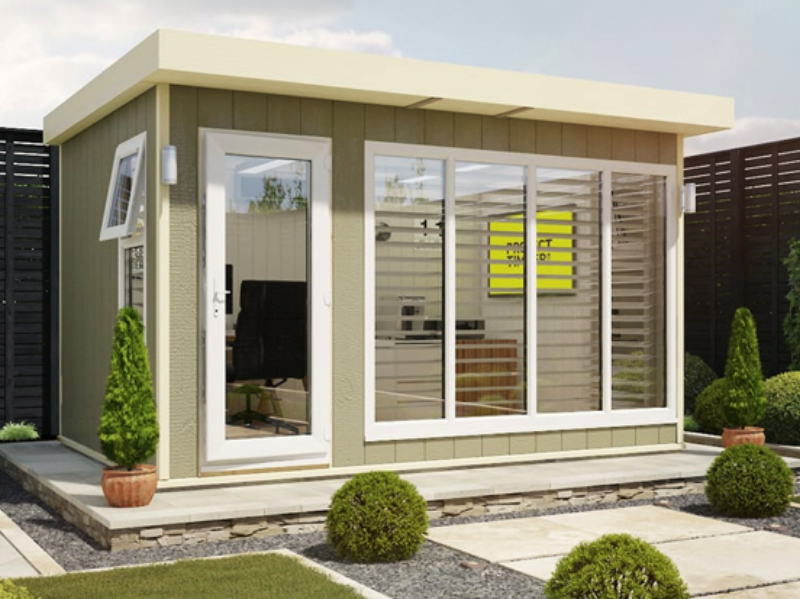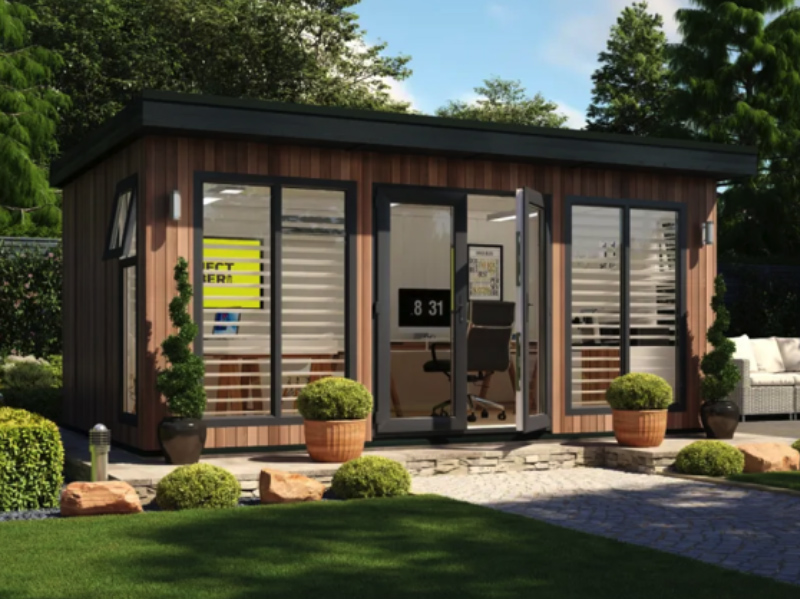Garden rooms have surged in popularity over recent years, becoming a sought-after option for those looking for extra, affordable living space. Your garden room can be built to serve many purposes, from home gyms and garden offices to studios and entertainment rooms. Garden rooms are able to blend functionality with the beauty of outdoor living.
But just how much does a garden room cost? Prices can range greatly for a garden room depending on size, materials, design, and the level of customization. A basic, DIY off-the-shelf wooden garden room can start from as low as £1,500 (without foundation, electricity or insulation) ie. a glorified shed! While a bespoke, fully equipped garden room installed with insulation, electricity and high-quality finishes can reach upwards of £30,000.
A garden room is a cost-effective solution for expanding living space and will add value to your property. Unlike a traditional home extension, a garden room does not usually require planning permission and takes a considerably shorter time to complete.
This post will aim to provide a comprehensive guide on how to build a garden room on a budget, exploring the different methods to provide a level foundation, cost saving tips on materials and how an OGEL garden room may be the perfect solution for your needs.
At OGEL we have designed a sustainable eco-friendly solution to build our garden rooms. These are built from recycled waste plastic, which not only helps in reducing waste but also promotes environmental sustainability.
The use of recycled plastic makes these structures highly durable, weather-resistant and virtually maintenance-free, which offers significant advantages over most traditional building materials. Additionally, the modular design of wall and roof panels allows for a quick and easy assembly, reducing labour costs and making them an ideal choice for people with DIY knowledge.
Planning your budget-friendly garden room
To prevent hurdles or unexpected costs during the construction of your garden room it’s essential to plan out all aspects of the project… from the type of base/foundation to the windows and doors to be installed.
Some tips for those on a budget:
- Prioritise your needs: decide what features are essential for your garden room… such as insulation, electricity and WiFi. Non-essentials could be bi-fold doors or high-end finishes.
- DIY where possible: consider what aspects of the construction you could do yourself as you could save a lot of money on labour costs.
- Research: you may find that some companies include ‘essential’ features as standard, such as OGEL with our “plug and play” electrical systems which only requires the installation of a power cable to the building, saving you an average of £500.
Basic cost examples of budget and premium DIY garden rooms.
DIY budget garden room cost breakdown for an untreated 2.5m x 2m tongue and groove log cabin

Foundation – £400
Building – £3,100
Electrics and lighting- £1,200 (completed by professional)
Insulation and plaster- £1,000
Interior finishes – £250
Total cost – £5,950
Image credit: dunster house
••••••••••••••••••••••••••••••••••••••••••••••
OGEL DIY Duo office pod – cost breakdown 3m x 1.6m

Foundation – £200
Building – £8,520
Total cost – £8,720
••••••••••••••••••••••••••••••••••••••••••••••
DIY premium garden office cost breakdown for a 2.5 x 1.8m

Foundation – £400
Building – £11,309
Electrics and lighting – £1,200 (completed by professional)
Interior finishes – £250
Total cost – £13,159
••••••••••••••••••••••••••••••••••••••••••••••
OGEL DIY The Durham cost breakdown 5m x 3m

Foundation – £400
Building – £15,170
Electrics and lighting – £200 (completed by professional)
Interior finishes – £0
Total cost – £ 15,770
••••••••••••••••••••••••••••••••••••••••••••••
Premium cedar clad garden room 4.8x3m

Foundation – £500
Building – £21,874
Electrics and lighting – £1,500 (completed by professional)
Interior finishes – £350
Total cost – £24,224
DIY vs. professional installation
Now you have a better idea of general pricing of garden rooms, the next thing to consider is the build and installation. Should you assemble your garden room yourself or pay for professional installation from the OGEL team?
There are pros and cons to both, and we’ve broken it down for you…
DIY installation
Pros
- Labour costs are essentially free (other than your time), as you’re doing the work. This can be a substantial saving, given that labour often accounts for a large amount of construction costs.
Cons
- You may need to purchase or rent tools and equipment, which can add to your costs if you don’t already have them.
- Without professional expertise, you might encounter mistakes that can be costly to rectify. Moreover, the project might take longer than anticipated, potentially leading to additional expenses.
Hiring professionals
Pros
- Expertise and experience, leading to potentially higher quality results.
- Professionals may obtain materials at a lower cost – thanks to trade discounts – and can work more efficiently, potentially offsetting some of the higher labour costs.
- Less stress for you, as the project management and construction are handled by the installation company.
Cons
- Hiring professionals will significantly increase the project’s cost.
If you are a ‘jack of all trades’, you may be able to complete all aspects of the project – from laying the foundation to installing the electrics – yourself, which will save you a lot of money as you will just be paying for the materials.
However, it’s unlikely that this will be the case for everyone. Although, if you’re handy enough to build flat-pack furniture, you can probably complete the majority of the work yourself… apart from the foundation (if using a concrete slab) and the fitting of the electrics.
Choosing between installing the garden room yourself and hiring professionals depends on your budget, skills and preferences. While DIY can offer significant savings, the expertise, efficiency and peace of mind that professionals bring to the table are benefits that might justify the extra cost.
Why choose an OGEL garden room?
The patented interlocking modular design of OGEL’s wall panels are the key factor in how construction can be completed so quickly and easily… taking minutes, rather than hours or even days, when compared to similar quality methods.
One of the main reasons for this is the minimal materials that are required. For instance, there is no external cladding or internal wall coverings needed to finish the building, saving you lots of time and money.
Although designed for people with DIY knowledge, opting for OGEL’s professional installation for your garden room, rather than going the DIY route, offers several advantages, particularly in avoiding the common pitfalls of DIY projects.
Benefits of OGEL’s installation service
- OGEL’s team provides professional knowledge to prevent typical DIY mistakes such as faulty foundations, thus ensuring structural integrity.
- The installation is quicker, allowing you to enjoy your garden room sooner.
- Professional installation guarantees high quality construction and adherence to safety and building regulations, avoiding issues like poor insulation or incorrect electrical wiring.
Common DIY errors
- Incorrectly laid foundations can lead to structural problems.
- Inadequate insulation/waterproofing.
- Unsafe electrical work.
- DIY projects can often expand beyond initial expectations, leading to delays and possible incomplete work.
Money saving tips for building a garden room on a budget
- Buy an ‘off the shelf’ kit or chose a simple design if going bespoke.
- Get the most out of the space by designing it to be multi-purpose.
- If the exterior requires cladding, use English treated softwood with a feathered edge or shiplap profile.
- Use natural or synthetic wool insulation instead of rigid insulation boards.
- Shop around different suppliers for deals on new materials.
- Use thick concrete slabs or ground screws, instead of pouring a concrete base
- Look for recycled or second hand materials such as reclaimed timber for framing.
- Instead of using plasterboard to finish internal walls, use sheets of OSB.
- You might be able to pull off your desired look using lino instead of laminate or hardwood flooring.
- Look to buy a demo/showroom model of the building you like.
- Pool together with friends, family or neighbours. Someone you know may also be looking to build a garden room, and you could get bigger discounts for buying the materials in bulk.
What makes an OGEL garden room cost effective?
- Built using recycled plastics that are highly durable and resistant to weather, decay and pests.
- Maintains integrity and appearance over time with minimal upkeep.
- The insulative properties of our walls and roof reduce the need for additional insulation.
- Buildings come with plug and play electrics included in the price.
- Time to complete. Due to the modular design construction of an OGEL garden room is very fast compared to other methods.
Maximising space and functionality
- Keep the layout open and flexible so you can adapt the space for various activities.
- Utilise vertical space with tall shelving units, wall-mounted cabinets and wall or ceiling hooks to keep the floor area uncluttered.
- Install a fold-down desk or table that can be tucked away when not in use.
- Optimise corner space with corner shelves, desks or cosy seating areas to maximise every inch of the room.
- Bench seating with built-in storage underneath provides a place to stash away items while keeping them within reach.
- Consider furniture pieces with hidden storage compartments, such as lift-top coffee tables or ottomans.
- A set of nesting tables can be expanded to create more surface area when needed and tucked away into a compact form after use.
OGEL’s modular construction makes it very easy to tailor a design for your specific needs. For instance, this building is built with two rooms… one becoming a designated work office, while the other a utility/storage room. This has freed up much needed space in the house that would otherwise only be gained from building an expensive extension or moving home.

Sustainability at its core
By utilising recycled materials with insulative properties, OGEL contributes to the reduction of waste in landfills and lessens the demand for new plastic production while using less materials than other premium garden rooms.
Minimal upkeep
Unlike traditional wood or metal structures that require regular treatments or replacement from weathering, rust, or decay, an OGEL garden room needs minimal upkeep.
Superior insulation properties
OGEL garden rooms offer excellent insulative properties, being comparable to a home cavity wall with 50mm insulation.
Planning permission
In many areas, certain types of garden rooms don’t require planning permission due to their classification under ‘permitted developments’. However, these rights vary based on local regulations, so it’s always best to check with your local planning authority. Generally, a garden room shouldn’t need planning permission if it follows these guidelines:
- Its use can be classed as ‘incidental’ to the home, such as using it as a home office or hobby room, not as separate living accommodation.
- If 2m outside of a boundary, it has a maximum eave height of 2.5 metres and maximum height of 4 metres with a dual-pitched roof or 3 metres for any other roof. If within a boundary roof height cannot exceed 2.5m.
- The garden room, along with other outbuildings, covers no more than 50% of the total area of the garden.
- It is not situated forward of the principal elevation or side elevation fronting a road.
- Your home is not listed or located in a designated area.
Conclusion:
Building a garden room on a budget needs careful planning, using cost-effective materials and you need to maximise its functionality. Here are the key points:
Plan carefully
- Establish a realistic budget early on, including a contingency fund for unforeseen expenses.
- Research local building regulations to avoid costly adjustments.
- Consider a simple yet functional design.
Cost-effective materials
- Explore sustainable materials like recycled plastics or reclaimed wood.
- Look for deals on materials and compare prices from different suppliers to find the best value.
- Invest in materials that are durable and low maintenance.
Maximise functionality
- Incorporate built-in storage and multi-functional furniture to make the most of the available space.
- Utilise vertical space using shelves and hooks
Opting for one of OGEL’s eco-friendly garden rooms can bring significant lasting benefits, including long-term durability, reduced maintenance, cost savings and a reduced environmental footprint. Made from recycled plastics, an OGEL garden room resists weather, rot and pests, lasting longer without the need for frequent repairs or treatments. Contact us today to get started with your garden room.



